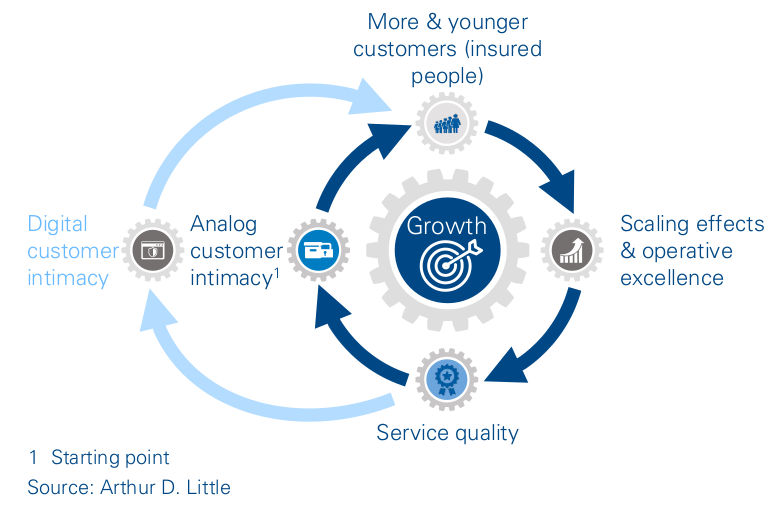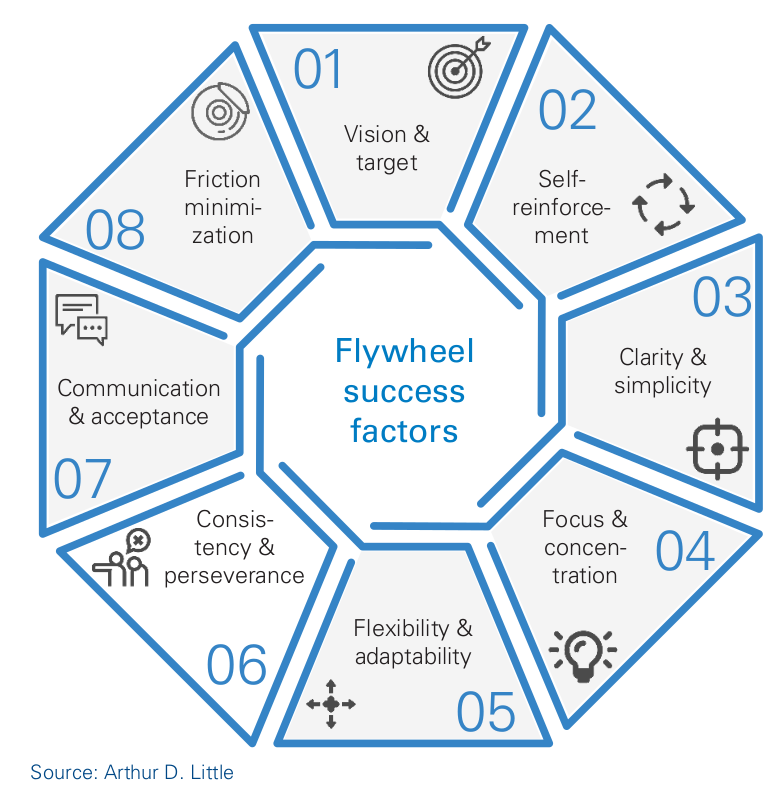
Today’s corporate world requires companies to look for a clear purpose for their business ventures, other than solely maximizing profits. This purpose, or in other words, the “why”, is essential for future success in an ever-changing and more and more digital business environment – to convince not only customers of the company’s offerings, but also investors of opportunities and employees of the company’s strategy.
Purpose: New pivot for successful digital transformations
Especially when it comes to a firm’s digital strategy, conveying the “why” is vital for success. In recent years, many traditional companies have struggled to remain competitive in an ever- growing digital environment. While some companies are retaining their competitiveness in light of the digital transition, or even capable of strengthening their positions, others are falling behind. There are good reasons to believe purpose, as such, plays an important role in this digital showdown.
As a matter of fact, a global survey published in the Harvard Business Review (2015; The Business Case for Purpose) found that most executives (84 percent) believed business transformation efforts would have a higher probability of success if they were supported by a clear business purpose. In line with this result, a majority of respondents (89 percent) were convinced that a shared purpose would lead to higher employee satisfaction, which is critical during organizational transformations.
In addition, studies revealed a positive correlation between business purpose and stock performance (Gartenberg, Prat, Serafeim, 2016; Corporate Purpose and Financial Performance).
As Larry Fink, the chairman and CEO of BlackRock, puts it: “Purpose guides culture, provides a framework for consistent decision-making, and ultimately helps to sustain long-term financial returns for shareholders of your company.”
And indeed, discussions with our clients have revealed thatan integrating element linking the different dimensions of a “digital shift” – that is what we call a comprehensive digital company transformation – seems to be crucial for succeeding. Admittedly, it might sound rather trivial to just focus on purpose to overcome the traps of digital transformation. However, from our experience, we see five key reasons companies fail during their transitions – and all are linked to purpose:
- Lack of common understanding and missing an overall goal (strategy): There is no clear understanding of what digitalization means for each of the different business units of the company and what the overall goal is. Only 20 percent of corporate strategists are aware of how digital transformation can enable their companies to win (Gartner, 2018; Mobilize Every Function in the Organization for Digitalization).
- No clear focus and lack of business benefit (technology): Many companies follow a one-size-fits-all approach, pursuing too many digitalization trends simultaneously. However, it is not expedient to implement AI, blockchain, the IoT and others within every company.
- Limited view of digitalization (ecosystems): Most transformation initiatives are too close to the current business model and existing business ecosystem. Due to exaggerated risk aversion, incremental changes are too often prioritized over disruptive measures.
- Missing employee enablement (people): Seventy percent of employees have stated that they do not understand the bigger picture and the impact on their day-to-day work life, and are lacking the necessary skills for digitalization (Gartner; Mobilize Every Function in the Organization for Digitalization). Dedicated training and support with regards to new technologies are simply missing or insufficient.
- Missing customer centricity (customer value): Digital initiatives are not always seen as means to an end – serving the customer and improving the product offering – but, rather, necessary initiatives in addition to existing business operations.
A solid digital strategy – the foundation for a successful digital shift – depends on a clear purpose and a way to spread it easily and effectively, inside and outside the company. Recently, a practical and effective framework to do so aroused interest among digital pioneers – the “flywheel”.
Flywheel: Maximizing impact through clear focus
A flywheel serves as a medium to depict the purpose of a business, and illustrates the most important levers to achieve the primary company goal. Originally the term “flywheel” described a mechanical device designed to efficiently store rotational energy. In a business context, the flywheel analogy captures the dynamic of implementing strategy through many individual measures aligned in one direction and reinforcing each other. As more results accumulate, the momentum of the flywheel builds and builds.
The flywheel showcases business logic in a simple, straight- forward manner. It primarily answers the following three key questions with regards to a company:
- What drives our business?
Focus and simplify in a ubiquitous digital world - What are our keys for transformation?
Derive transformation measures to accelerate growth - How can we maximize customer value?
Align business activities with customer needs
To convey the flywheel concept, we use a client’s flywheel in the insurance sector:

Historically, analog customer intimacy has been a major differentiating factor for the insurance sector and led to increased customer numbers – this importance, however, will decrease in future.
An example in health insurance is as follows: looking at the flywheel, it becomes clear that a high number of insured customers leads to economies of scale in administrative tasks. Younger customers (insured people) are usually healthier and thus incur fewer costs per insured person, which again results in a higher budget. Scaling effects and a solid financial budget can then be used to improve customer service. Innovative, customer-oriented digital services increasingly determine a company’s competitive edge – replacing the classic analog intimacy – raising the numbers of customers and supporting growth as the primary company goal.
What’s in it for me?
The healthcare insurance example illustrates how the flywheel helps to depict the business purpose and clarify the individual core drivers necessary for growth. In another example, the clearly defined business purpose was the basis for a company’s large-scale, successful digital transformation approach:
- Clear direction: Based on the clear main business purpose, high-level ambitions for the company-wide digital transformation had been defined to give orientation. Additionally, concrete, measurable target pictures per business process had been set up to track digitalization achievements (e.g., 95 percent of claims processing would be fully automated in four years). As a result, the company was able to de-prioritize resource-consuming digital efforts that were not contributing to the dimensions of the flywheel (e.g., that had no impact on customer intimacy).
- Increased engagement: The clearly described business purpose helped to communicate the vision of digital transformation and increased employee motivation and engagement. Various change management activities and agile formats were introduced to support the digital transformation.
- Tangible results: Based on clear focus and employee engagement, the speed of digitalization has massively increased. Already, throughout the first year, 70+ digitalization measures, including new technologies, have been defined, prioritized and introduced. All these measures pay into the levers of the flywheel, reinforcing each other and supporting the company ́s growth.
Cornerstones of flywheel success for digital transformation
For the flywheel to serve as a purposeful tool that is accepted company wide for the digital transformation strategy, it is critical to involve top-level management and other key stakeholders in the development process early on. Our experience fromdigital transformation projects has proven that it can be highly effective to set up a series of workshops, aiming to analyze the company’s current situation, outline its vision and ambitions, and ultimately develop its flywheel collectively.
As simple as the flywheel looks in its illustration, development of this joint purpose is a demanding exercise. Throughout the development and implementation process, eight key factors determine the success of the flywheel approach:

Quick-start advice for effectively building and implementing your own flywheel:
- Vision and target: Having ensured the involvement of your key decision-makers, the most important prerequisite for developing an appropriate flywheel is a clear goal and vision. This includes defining the company’s guiding principle and enduring core values. Only when these are strong and clear can you think about a meaningful flywheel that will lead you towards that goal.
- Self-reinforcement: You need to ensure that, cumulatively, each of your identified business drivers support and accelerate the other business drivers. If they do not act and reinforce each other, it will be hard to gain the necessary momentum to drive the digital transformation process. On the contrary, if you identify a “stand-alone” business driver, it might be wise to challenge its existence in your flywheel: is it still the right driver nowadays, or is it a legacy of the past? Make sure the flywheel has a logical start, and that the following components represent an outcome for the previous components and thus make sense of the overall loop cycle.
- Clarity and simplicity: To be a powerful tool for your internal and external communication, your flywheel must be clear and easy to grasp. Otherwise, it will remain challenging to convince employees, investors, etc. Your flywheel should succinctly answer the question: “How do we achieve our goal?” Like any good idea, the flywheel should fit on a small, square napkin, and therefore consist of no more than five to eight key business drivers. Nevertheless, it is very important to recognize that this requirement of simplicity is not about being easy. It is about explanatory power. Or as Steve Jobs put it: “Simple can be harder than complex: you have to work hard to get your thinking clean to make it simple. But it’s worth it in the end because once you get there, you can move mountains.”
- Focus and concentration: Your flywheel should not onlytell you what to do, but also what should no longer be done. Its key drivers should focus on the company’s strength and the advantages it may already have over others. To identify these key drivers, it can be helpful to generate a list of past successes and failures, which will ultimately guide you in generating your key flywheel components. Of course, new strengths can be built up if this is the best way to achieve the goal. But as a rule, it is easier and more effective to concentrate on what resources are already available. Ideally, your flywheel should make it clear how you stand out from your competitors. How do you position yourself in the market? What do you do differently? And what do you do better – for the benefit of your customers?
- Flexibility and adaptability: “It is not the strongest of the species that survives, nor the most intelligent that survives. It is the one that is most adaptable to change.” Charles Darwin’s famous theory of evolution from the 19th century applies to not only nature, but also today’s digital economy. In the quote above, one could easily replace the word “species” with “companies”. Only companies that adapt to changing market conditions, and are thus one step ahead of their competitors, have the chance to survive in the market. Regular transformations are therefore the basis for constant and sustainable growth. Therefore, we recommend revising your flywheel approach every two to three years.
- Consistency and perseverance: Of course, you must constantly check whether your strategy is still correct. To stick to the wrong strategy until the bitter end would be fatal. However, it is too easy for many to be diverted as soon as the first difficulties arise. In that case, perseverance is required. Keep up your strategy. Only continuity ensures that your employees will internalize your flywheel, and thus act and prioritize accordingly.
- Communication and acceptance: A flywheel that exists only on paper does not bring any company forward. Your employees must understand and accept your flywheel. Only then can everyone together lead the company to its goal. Therefore, timely, open and sensitive communication with employees is crucial. Pushing employees in a certain direction will result in resistance. But providing them with a conceivable goal will lead to an intrinsic push. As a rule, everyone who is needed to achieve strategic momentum must know and understand how to establish it.
- Friction minimization: Since you’re applying force to your flywheel, you also need to make sure nothing is opposing it – that means eliminating friction from your business strategy. You can reduce friction by identifying your existing pain points – those that negatively influence and act on the key business drivers. Based on those identified pains it becomes possible to formulate your critical digital needs and define specific activities, which will minimize or even eliminate identified weaknesses and risks.
Outlook & conclusion
Once you have developed your company-specific flywheel, it can not only serve as an effective tool for company-wide communication, but also function as the central guiding principle for managing digital transformation. With just a few arrows, the flywheel makes it possible to quickly and effectively capture and depict the purpose and strategically relevant drivers of your business. Hence, from our perspective, it is the inevitable tool to create the strategic momentum necessary to achieve a successful digital shift.


